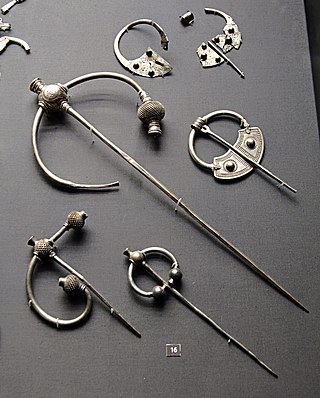
The British Museum is a public museum dedicated to human history, art and culture located in the Bloomsbury area of London. Its permanent collection of eight million works is the largest in the world. It documents the story of human culture from its beginnings to the present. The British Museum was the first public national museum to cover all fields of knowledge.
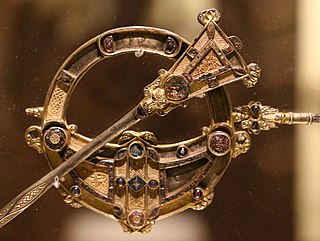
The Tara Brooch is an Irish Celtic brooch, dated to the late-7th or early-8th century, of the pseudo-penannular type. It is made from bronze, silver and gold, with a head formed from a circular ornate ring that is intricately decorated on both sides. Its upper half is hollow while the lower half is solid with fused terminals. The brooch was constructed from numerous individually made pieces, and its front and reverse sides are both decorated with around 50 inserted cast panels containing highly ornate filigree. The borders and terminals contain multiple panels holding multi-coloured studs, interlace patterns, filigree and Celtic spirals. It is widely considered the most complex and ornate of its kind, and would have been commissioned as a fastener for the cloak of a high ranking cleric or as ceremonial insignia of high office for a High King of Ireland.

Filigree is a form of intricate metalwork used in jewellery and other small forms of metalwork.

The quoit brooch is a type of Anglo-Saxon brooch found from the 5th century and later during the Anglo-Saxon settlement of Britain that has given its name to the Quoit Brooch Style to embrace all types of Anglo-Saxon metalwork in the decorative style typical of the finest brooches. The brooches take their modern name from the rings thrown in the game of quoits, and have the form of a broad ring, or circle with an empty centre, usually in bronze or silver, and often highly decorated. The forms are in a very low relief, so contrasting with other early Anglo-Saxon styles, with detail added by shallow engraving or punching within the main shapes. Dots or dashes are often used to represent fur on the animal forms, as well as lines emphasizing parts of the body. They are fixed with a single, straight hinged pin like those of other Anglo-Saxon ring or Celtic brooches and are further defined by the presence of a slot and pin-stops on the ring.




The Celtic brooch, more properly called the penannular brooch, and its closely related type, the pseudo-penannular brooch, are types of brooch clothes fasteners, often rather large; penannular means formed as an incomplete ring. They are especially associated with the beginning of the Early Medieval period in Ireland and Britain, although they are found in other times and places—for example, forming part of traditional female dress in areas in modern North Africa.
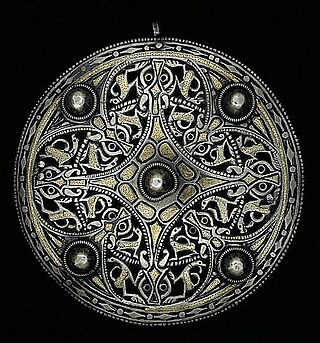
Trewhiddle style is a distinctive style in Anglo-Saxon art that takes its name from the Trewhiddle Hoard, discovered in Trewhiddle, Cornwall in 1770. Trewhiddle ornamentation includes the use of silver, niello inlay, and zoomorphic, plant and geometric designs, often interlaced and intricately carved into small panels. Famous examples include the Pentney Hoard, the Abingdon sword, the Fuller brooch, and the Strickland brooch.
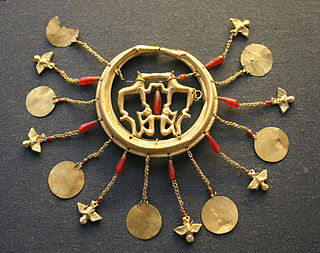
The Aegina Treasure or Aigina Treasure is an important Minoan gold hoard said to have been found on the island of Aegina, Greece. Since 1892, it has been part of the British Museum's collection. It is one of the most important groups of Minoan jewellery.

The Beaurains Treasure is the name of an important Roman hoard found in Beaurains, a suburb of the city of Arras, northern France in 1922. Soon after its discovery, much of the treasure was dispersed, to be sold on the antiquities market. The largest portion of the hoard can be found in the local museum in Arras and in the British Museum.

The Domagnano Treasure is an important Ostrogothic hoard found at Domagnano, Republic of San Marino in the late nineteenth century. The treasure is now divided among various institutions, including the Louvre Abu Dhabi, although the bulk of the hoard is currently held by the British Museum in London and the Germanisches Nationalmuseum in Nuremberg.

The Sutri Treasure is an important Lombardic hoard found at Sutri, Italy in the late nineteenth century that is currently in the collections of the British Museum in London.

The Belluno Treasure is an important Lombardic hoard found at Belluno, Italy in the nineteenth century that has been part of the British Museum's collection since 1897.

The Bergamo Treasure is a large Lombardic and Ostrogothic hoard found near the city of Bergamo in northern Italy in the nineteenth century. It was mostly acquired by the British Museum in 1897.
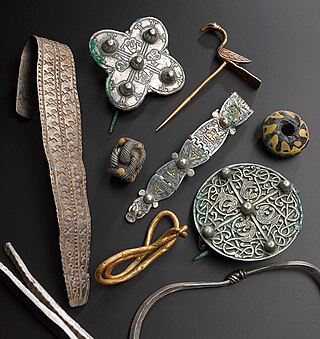
The Galloway Hoard, currently held in the National Museum of Scotland, is a hoard of more than 100 gold, silver, glass, crystal, stone, and earthen objects from the Viking Age discovered in the historical county of Kirkcudbrightshire in Dumfries and Galloway in Scotland in September 2014. Found on Church of Scotland land, the hoard has been described by experts as "one of the most significant Viking hoards ever found in Scotland". With years of extensive study and research, scholars are still not certain who buried the hoard, why they did so and whether they were Vikings or Anglo-Saxons. During the Viking Age, Galloway found itself squeezed between two Viking kingdoms and essentially cut off from other Anglo-Saxons in Britain - "Galloway is where these different cultures were meeting. It’s not just Scandinavians, but people from Britain and Ireland as well."

Scottish jewellery is jewellery created in Scotland or in a style associated with Scotland, which today often takes the form of the Celtic style. It is often characterised by being inspired by nature, Scandinavian mythology, and Celtic knot patterns. Jewellery has a history in Scotland dating back to at least the Iron Age.

The Pentney Hoard is an Anglo-Saxon jewellery hoard, discovered by a gravedigger in a Pentney, Norfolk churchyard in 1978. The treasure consists of six silver openwork disc brooches, five made entirely of silver and one composed of silver and copper alloy. The brooches are decorated in the 9th century Trewhiddle style. The hoard is now in the British Museum.
 Part of the Artres Treasure displayed in the British Museum
Part of the Artres Treasure displayed in the British Museum






